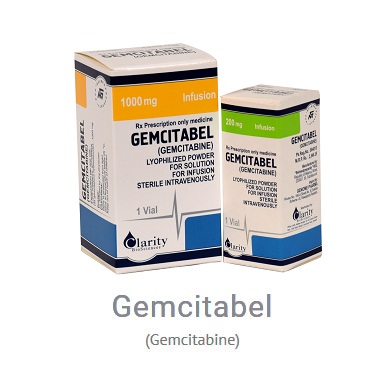
Gemcitabel
(Gemcitabine)
Composition:
Each 10 ml vial contains gemcitabine (as gemcitabine hydrochloride) 200 mg and 1000 mg.
ATC Code
L01BC05 — Gemcitabine
Structure

Description
Gemcitabine is a nucleoside analog used as chemotherapy. As with fluorouracil and other analogues of pyrimidines, the drug replaces one of the building blocks of nucleic acids, in this case cytidine, during DNA replication. The process arrests tumor growth, as new nucleosides cannot be attached to the “faulty” nucleoside, resulting in apoptosis (cellular “suicide”).
Gemcitabine is used in various carcinomas: non-small cell lung cancer, pancreatic cancer, bladder cancer and breast cancer. It is being investigated for use in oesophageal cancer, and is used experimentally in lymphomas and various other tumor types.
Indication
- Gemcitabine is indicated for the treatment of advanced ovarian cancer that has relapsed at least 6 months after completion of platinum-based therapy; metastatic ovarian cancer; inoperable, locally advanced (Stage IIIA or IIIB), or metastatic (Stage IV) non-small cell lung cancer; and locally advanced (nonresectable Stage II or Stage III) or metastatic (Stage IV) adenocarcinoma of the pancreas.
Associated Conditions
- Advanced Ovarian Cancer
- Carcinoma Breast Stage IV
- Locally Advanced Biliary Tract Cancer
- Locally Advanced Non-Small Cell Lung Cancer
- Locally Advanced Pancreatic Adenocarcinoma
- Metastatic Biliary Tract Cancer
- Metastatic Bladder Cancer
- Non-small Cell Lung Cancer (NSCLC), Stage IV
- Advanced Bladder cancer
- Stage 4 Pancreatic adenocarcinoma
Pharmacodynamics
Gemcitabine is an antineoplastic anti-metabolite. Anti-metabolites masquerade as purine or pyrimidine – which become the building blocks of DNA. They prevent these substances becoming incorporated in to DNA during the “S” phase (or DNA synthesis phase of the cell cycle), stopping normal development and division. Gemcitabine blocks an enzyme which converts the cytosine nucleotide into the deoxy derivative. In addition, DNA synthesis is further inhibited because Gemcitabine blocks the incorporation of the thymidine nucleotide into the DNA strand. It demonstrates dose-dependent synergistic activity with cisplatin in vitro. In vivo, gemcitabine showed activity in combination with cisplatin against the LX-1 and CALU-6 human lung xenografts, but minimal activity was seen with the NCI-H460 or NCI-H520 xenografts. Gemcitabine was synergistic with cisplatin in the Lewis lung murine xenograft. Sequential exposure to gemcitabine 4 hours before cisplatin produced the greatest interaction.
Mechanism of Action
Gemcitabine inhibits thymidylate synthetase, leading to inhibition of DNA synthesis and cell death. Gemcitabine is a prodrug so activity occurs as a result of intracellular conversion to two active metabolites, gemcitabine diphosphate and gemcitabine triphosphate by deoxycitidine kinase. Gemcitabine diphosphate also inhibits ribonucleotide reductase, the enzyme responsible for catalyzing synthesis of deoxynucleoside triphosphates required for DNA synthesis. Finally, Gemcitabine triphosphate (diflurorodeoxycytidine triphosphate) competes with endogenous deoxynucleoside triphosphates for incorporation into DNA.
Product Information
Share This Story, Choose Your Platform!
